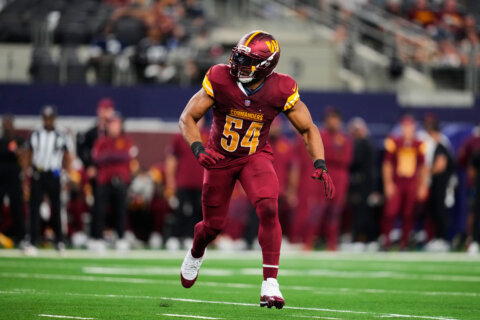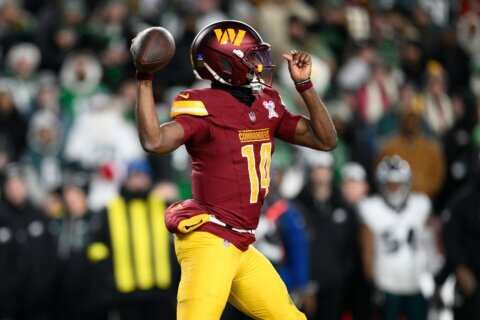
The Washington Football Team saw their unique season wrap up Saturday night with a 31-23 loss to Tampa Bay.
And what a year it has been, from a new coach to the COVID-19 pandemic limiting minicamps and offseason workouts. From a name change to the changing of the radio broadcast booth. A coach recovering from cancer. From a failed first-round pick’s exit to the incredible comeback of an injured veteran. New stars on both sides of the ball. Special teams that gave us equal parts satisfaction and frustration. An NFC East division of depression and implosion.
For those that follow the local NFL club, 2020 was a buffet table of stories as well as twists and turns. We’ll have plenty of fat to chew on in the offseason.
Come to think of it, I’ll have a Heinicke: One month removed from studying for finals, the former Old Dominion quarterback got the start when Alex Smith’s calf injury prevented “The Comeback” from shooting any playoff scenes. The 27-year-old completed 26-44 passes for 306 yards and a touchdown with an interception. Heinicke also led the team in rushing with 46 yards on six carries while running for a score. But before you start penciling No. 4 in your program as No. 1 on the depth chart, let’s look at the other quarterbacks to start a playoff game for the Burgundy & Gold in the last 20 years:
- Mark Brunell, 2005: 3-6 over nine starts the following year and then off to New Orleans.
- Todd Collins, 2007: three relief appearances in over the next two seasons before finishing his career in Chicago.
- Robert Griffin III, 2012: 20 starts over the next three years with increasing injuries for the player and headaches for the team, plus diminishing returns on the field before departing.
- Kirk Cousins, 2015: two years of good stats for a .500 team before getting one sweet payday from Minnesota.
Running in circles: The Burgundy & Gold were going against the top-ranked run defense and it showed. Antonio Gibson was held to 31 yards on 14 carries while J.D. McKissic managed 5 yards on two attempts. They each had a pair of “long handoffs.” The position group could use some offseason sprucing (Peyton Barber averaged a career-low 2.7 yards per carry), but one likes the future here.
Run TMC: Terry McLaurin caught six passes for 75 yards while being upstaged by Cam Sims, who notched seven receptions for 104 yards. Logan Thomas resumed his role of security blanket with five grabs for 74 yards, while Steven Sims recorded three catches for 33 yards. Moving forward, we want to see more from both Sims, but there’s a good base here with McLaurin and Thomas as targets.
Third and encouraging: The offense moved the chains on 7-14 attempts, with one run called (J.D. McKissic scored a 2-yard TD on 3rd & goal from the 2) in the mix. Heinicke completed 8-11 passes for five conversions, while scrambling for a touchdown and getting sacked once (late in the fourth quarter). Logan Thomas had the most targets (4) while Steven Sims had the most catches (3). Yardage Breakdown: 2-2 on short-yardage, 4-4 when needing 4 to 6 yards, and 1-8 on long-yardage.
Defending the defense: The 31 points allowed are obviously less than ideal, but the D kept Tampa Bay in check in the first half by holding them to field goals after their offense reached the red zone twice. They also held Tom Brady & Co. to 6-14 on third down. Unfortunately, they couldn’t keep the Buccaneers from scoring in the second half (allowing points on three consecutive fourth-quarter possessions). Jeremy Reaves led the way with 10 tackles, while Daron Payne notched a pair of sacks. Jon Bostic’s fumble recovery led to a second-half touchdown. There’s a lot to build off this unit. We wonder if impending free agent Ryan Kerrigan returns in a limited role. We’re also excited about the possibilities of a defense that ranked second in the NFL.
Special situations: Dustin Hopkins kicked a 36-yard field goal while converting both extra points. Two of his five kickoffs were touchbacks, two were returned and his onside kick was recovered by Tampa Bay. Tress Way averaged 43.8 yards over five punts, with one landing inside the 20 and one touchback. Danny Johnson returned a kickoff 31 yards while there were no punt returns (given the recent shenanigans, that’s a good thing). Kickoff coverage allowed returns of 8 and 18 yards, and punt coverage surrendered returns of 7 and 9 yards.
Flying flags: WFT was whistled only twice for 25 yards. When added to the regular season, they were penalized 89 times for 722 yards. For comparison, the 2019 team was flagged 106 times for 835 yards. This week’s infractions were a facemask penalty on the first play from scrimmage and an offensive hold in the second half. Neither were disastrous, although Kendall Fuller’s facemask helped jump-start the Buccaneers’ first scoring drive, and Brandon Scherff’s hold turned a 1st & 10 at the Tampa Bay 40 into a 3rd & 17 at the Washington 35 (they’d wind up punting).
Planting seeds on the home field: Home teams went 2-4 this past weekend with both No. 3 and No. 4 seeds getting early vacations. And the teams that won would have had first-round byes in 2019. In the previous playoff expansion, the No. 3 seed won both games in 1990 but then would split for seven of the next nine seasons. The 4/5 game under the current format is somewhat tricky as it involves the division winner with the worst record and the Wildcard with the best regular season mark. Under the current format that has been in existence since 2002, there have been 24 times in the last 19 years where the Wildcard has had a better record than the division winner (Washington’s hosted three such games, including this year). Washington’s loss Saturday means the home teams are now 12-12 in those situations.








